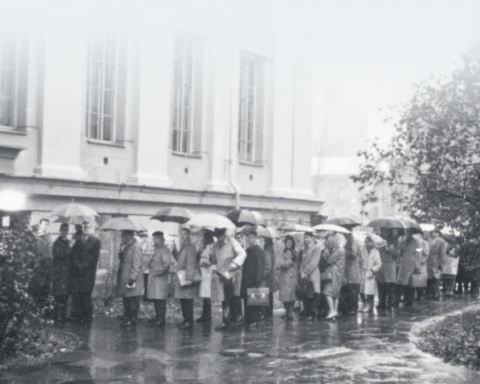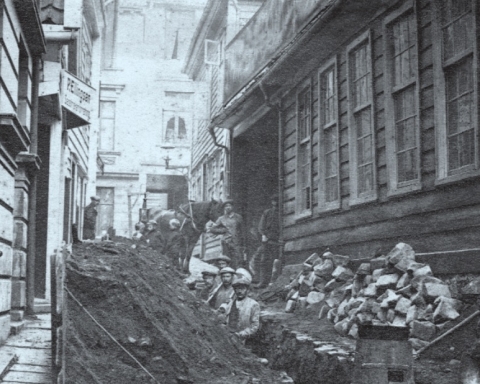If we compare the bibliographies of Halvdan Koht (1873−1964) and Edvard Bull (1881−1932) with those of the next scholarly generation, represented here by Sverre Steen, Jens Arup Seip, and Andreas Holmsen, one is instantly struck by the degree to which Norwegian historiography became nationally confined after World War II.
Steen was, like Koht, a very prolific writer, who blended his roles as scholar, teacher, and popular educators in his practice as a historian. But apart from a few translated texts and reviews of foreign books, there are very few examples of works that could be called international in any reasonable meaning of the term. Seip was, like Bull, almost the prototype of the professional researcher who emphasized path-breaking research and scholarly excellence. But his bibliography does not include one single work written in a foreign language. Both Steen and Seip could thus, in Robert Merton’s terminology, be classified as “locals” rather than “cosmopolitans”, but they were “locals” of rather different kinds.
Jens Arup Seip: norm-sender and gatekeeper

The case of Jens Arup Seip, who probably qualifies as the leading norm-sender and gatekeeper in postwar Norwegian historiography, illustrates particularly well the striking, multidimensional contraction of historical scholarship that took place in the decades after World War II: First, the withdrawal from the networks and practices of a broader “history culture” to that of the exclusive community of academic historians. Second, the withdrawal from the more loosely differentiated community of humanistic scholars to that of the history discipline, which was defined through rather aggressive forms of “boundary work” vis-à-vis other humanistic and social-scientific disciplines. And third, the self-conscious concentration on national historiography at the expense of more international themes and approaches.
One of the most striking expressions of what we might call a nationalization of the discipline is the way in which the comparative dimension to Koht and Bull’s materialistic research program was washed out in the early postwar era. This is neatly demonstrated by the destiny of the large project on the historical evolution of peasant society at the Oslo Institute for the Comparative Study of Human Culture, which had been planned by Bull and was continued for decades after World War 2 under the leadership of Andreas Holmsen (professor from 1955). This case has been carefully analyzed by Jon Røyne Kyllingstad and I will therefore be brief.
A project which was planned as a theoretically ambitious, comparative European project ended up in the postwar era as an endless empirical registration project, confined to Norway and almost completely devoid of any coherent theoretical foundation.
While there were several more “contingent” reasons for this national drift, which I shall not discuss here, Kyllingstad argues that the project became victim of two more general mechanisms. First, the absorption in an enormously large and complex empirical material impeded not only international comparison, but virtually all kinds of synthetic theorizing. Second, the strength of national traditions made the problem-horizon of Norwegian national historiography prevail over those comparative-international problems Bull had sought to address, which related to his general historical materialism. Much of Holmsen’s and his pupils’ scholarship thus addressed the problem of “Norway’s decline in the late Middle Ages”, a highly strategic question for nation-building historians in the 19th century, but hardly a fruitful focus of comparative, multinational studies.
Another striking expression of similar trends is Ottar Dahl’s textbook Norwegian Historical Research in the 19th and 20th Centuries from 1959, which has been reprinted and revised several times and still remains the standard work on Norwegian historiography. The book could be read as a new postwar generation’s attempt to come to terms with a national scholarly tradition which it both criticized and connected to. Dahl built his book on two basic premises: first, that linear scientific progress in history was possible and indeed had come about through a combination of meticulous source criticism and scholarly debate, and second, that Norwegian historical research could best be portrayed by focusing on a number of strategic problems which all related to a national discourse rooted in the 19th century. Hence, while criticizing nationalism as an overt ideology, the postwar generation largely continued to operate within a “problem matrix” generated by the nationalist discourse they rejected. This could be regarded the “Trojan horse” in Norwegian historiography, and this horse, I would argue, is to a larger extent than we tend to believe still with us today.
Diciplining the historians
The national concentration in Norwegian historiography was, as many have pointed, partly a consequence of a particular set of scholarly norms which were defended and policed with great force in the early postwar period. Such norms could be found in an explicit form for instance in expert judgments of applicants to professorships or in doctoral disputations. Apart from working with such printed and “official” material, meant for the front stage, I have examined Jens Arup Seip’s correspondence which gives some highly interesting glimpses into the back stage of the discipline with its more informal and sometimes gossipy valuations of colleagues and juniors.
Both categories of sources give a strong impression of a norm system that valued hand-to-hand combat with the sources (Seip), the ability to immerse oneself deeply into the historical context and to make intellectual order out of tremendous empirical complexity. In short, what was most highly valued was the combination of a craft-like mastery of source criticism and an aesthetic mastery of literary form. The ideal historian should thus be a synthesis of those two scholarly characters which Simon Larsson calls “martyr of the archive” and “aristocrat of intelligence”.
There are many noteworthy negative and positive phrases in Seip’s letters that describes this ideal, often in a highly personal and existential form. This norm system did quite obviously favor in-depth studies in the historian’s own society while discouraging explorations in foreign lands as well as systematic comparisons across time and space. (Seip’s letters and published works indeed contain strong statements about the impossibility of comparing complex units and processes.)
This “disciplining” of the historians was underpinned by a social process by which history strengthened its institutional autonomy within the academic field. Integral to this process was an increasing hierarchy between the community of historical researchers and the profession of academically educated history teachers. Seip often spoke warmly about the new historical milieu that had emerged in the postwar era, and often referred to the community of historical scholars as “our historical republic”. Both labels were reserved for the national community of professional researchers. The successful institutionalization of historical research in the postwar era produced a critical social mass which made the discipline more self-sufficient both vis-à-vis other disciplines and vis-à-vis the international scholarly community.
Changing trends
The dramatic expansion of the higher-education system since the 1960s has produced a national community of historians many times the size of the “critical mass” that emerged in the 1950s. This has obviously changed the situation radically. There is now much greater variety and specialization within the discipline, and the norms of historical scholarship have become much more diverse. The identity politics of minority and underprivileged groups, an integral dimension to the ideological upheaval of the 1960s and 1970s, have drawn historians’ attention to sub-national and transnational objects of study. These trends have on the one hand, as Jan Eivind Myhre and others have argued, opened new paths to international literature and scholarly cooperation. A few university teachers and quite a number of students and research fellows have specialized in the history of other lands and regions, such as the Middle East and Northern Africa (Bergen), Sub-Saharan Africa (Trondheim), and South-East Asia (Oslo). Much of this research has been stimulated by external grant programs from the Norwegian research council and other sources. But as Jarle Simensen noted in 1989, the growth of non-European history was not paralleled by a similar expansion in the study of European or North-American history.
This is perhaps not so surprising. For in those very decades after 1970 when Norwegian historical research became internationalized, largely as a function of specialization, the European dimension to the history curricula both in universities and higher schools declined dramatically. There was an obvious interconnection here: With the fall of the old Gymnasium, English, German and French history was in a sense reduced from being essential elements in humanistic education to becoming merely so many research specialties among other specialties. This tendency was reinforced by the tendency in academe to privilege research over learning. A comparison of history curricula at the University of Oslo from the 1920s to the 1960s shows a gradual transition in the study of European history towards elementary textbooks, while the opposite was true of Norwegian history.
An even more dramatic decline occurred in the general knowledge of Nordic history as a framework for studying Norwegian history. Up to the 1950s, bifag and hovedfag students had one major exam in European history and one in Nordic history. Most of these latter assignments were about Norwegian history, but it happened quite often that the students were asked questions from Danish, Swedish, or, more rarely, Icelandic history instead. Today, our students learn virtually nothing about the history of the other Nordic countries. The breaking point seems to have been in the 1960s.
Hence, while historians became internationalized qua specialized scholars, they were far less “cosmopolitan” in their general historical orientation than their predecessors. The consequences of this national provincialization should not be underestimated.
The current situation
Much of the present thinking about the “internationalization” of science and of higher education seems to be modeled on the natural sciences. The assumption is, essentially, that internationalization is fostered by professionalized, specialized research, since specialized research communities are world-wide and merits at the “research frontier” are impossible without global networks of communication. In the humanities, however, the situation is more complex. Internationalism could mean a spectrum of different things, and has meant different things in different historical contexts. Hence, the specific meaning of “internationalism” which is implied in current research policies should not be taken for granted.
The recent evaluation of Norwegian historical research, led by Professor Bo Stråth, recommended that Norwegian historians should make much more active use of their international networks to transcend their “methodological nationalism”. This is a recommendation I would support. But I would add that “internationalization” driven by scientific specialization should be combined by the kind of intellectual cosmopolitanism that follows from broad, catholic reading. That would call for changes in our habitual ways of thinking about historical education and training.
Fredrik W. Thue er post doc ved Institutt for arkeologi, konservering og historie ved Universitetet i Oslo. Innlegget er en modifisert versjon av Thues bidrag til Nordisk historikermøte i Tromsø i august 2011.





Her er det noen veldig interessante tanker om hva «internasjonalisering av historefaget» egentlig bkan bety. Jeg sympatiserer med klagesangen over et svinnende lærdomsideal innenfor faget og med oppfordringen til bred lesning. Men mon spenningen mellom historie som lærdom og historie som forskning er sterkere enn det den romslige konklusjonen åpner for? Konsekvensene av en dyrking av lærdomsidealet er en internasjonalisering ”innover”, der en tar inn over seg litteratur fra det store utland – mens konsekvensen av forskeridealet er en internasjonalisering ”utover”, der en deltar i internasjonale nettverk. Må man kanskje velge om man vil være kosmopolitt eller målrettet spesialist?